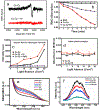A powerful combination of copper-cysteamine nanoparticles with potassium iodide for bacterial destruction
- PMID: 32204087
- PMCID: PMC7100965
- DOI: 10.1016/j.msec.2020.110659
A powerful combination of copper-cysteamine nanoparticles with potassium iodide for bacterial destruction
Abstract
Herein, for the first time, we demonstrate that the combination of copper-cysteamine (Cu-Cy) nanoparticles (NPs) and potassium iodide (KI) can significantly inactivate both Gram-positive MRSA and Gram-negative E. coli. To uncover the mystery of the killing, the interaction of KI with Cu-Cy NPs was investigated systematically and the products from their interaction were identified. No copper ions were released after adding KI to Cu-Cy NPs in cell-free medium and, therefore, it is reasonable to conclude that the Fenton reaction induced by copper ions is not responsible for the bacterial killing. Based on the observations, we propose that the major killing mechanism involves the generation of toxic species, such as hydrogen peroxide, triiodide ions, iodide ions, singlet oxygen, and iodine molecules. Overall, the powerful combination of Cu-Cy NPs and KI has good potential as an independent treatment or a complementary antibiotic treatment to infectious diseases.
Keywords: Bacterial killing; Copper; Copper-cysteamine; Nanoparticles; Photodynamic therapy; Photosensitizer; Potassium iodide; Reactive iodine species.
Copyright © 2020 Elsevier B.V. All rights reserved.
Conflict of interest statement
Declaration of competing interest There are no conflicts of interest to declare.
Figures






Similar articles
-
Exploration of Copper-Cysteamine Nanoparticles as a New Type of Agents for Antimicrobial Photodynamic Inactivation.J Biomed Nanotechnol. 2019 Oct 1;15(10):2142-2148. doi: 10.1166/jbn.2019.2829. J Biomed Nanotechnol. 2019. PMID: 31462378 Free PMC article.
-
A facile method for the synthesis of copper-cysteamine nanoparticles and study of ROS production for cancer treatment.J Mater Chem B. 2019 Nov 14;7(42):6630-6642. doi: 10.1039/c9tb01566c. Epub 2019 Oct 8. J Mater Chem B. 2019. PMID: 31591609
-
Potassium Iodide Potentiates Broad-Spectrum Antimicrobial Photodynamic Inactivation Using Photofrin.ACS Infect Dis. 2017 Apr 14;3(4):320-328. doi: 10.1021/acsinfecdis.7b00004. Epub 2017 Feb 23. ACS Infect Dis. 2017. PMID: 28207234 Free PMC article.
-
Potentiation of antimicrobial photodynamic inactivation by inorganic salts.Expert Rev Anti Infect Ther. 2017 Nov;15(11):1059-1069. doi: 10.1080/14787210.2017.1397512. Epub 2017 Oct 31. Expert Rev Anti Infect Ther. 2017. PMID: 29084463 Free PMC article. Review.
-
Characteristics of the copper-induced viable-but-non-culturable state in bacteria.World J Microbiol Biotechnol. 2021 Feb 5;37(3):37. doi: 10.1007/s11274-021-03006-5. World J Microbiol Biotechnol. 2021. PMID: 33544256 Free PMC article. Review.
Cited by
-
Phenylalanine-Arginine-β-Naphthylamide Enhances the Photobactericidal Effect of Methylene Blue on Pseudomonas aeruginosa.Photobiomodul Photomed Laser Surg. 2023 Oct;41(10):569-575. doi: 10.1089/photob.2023.0005. Photobiomodul Photomed Laser Surg. 2023. PMID: 37870413 Free PMC article.
-
Copper-cysteamine nanoparticle-mediated microwave dynamic therapy improves cancer treatment with induction of ferroptosis.Bioact Mater. 2022 Dec 28;24:322-330. doi: 10.1016/j.bioactmat.2022.12.023. eCollection 2023 Jun. Bioact Mater. 2022. PMID: 36632507 Free PMC article.
-
Luminescence Nanomaterials and Applications.Nanomaterials (Basel). 2023 Mar 14;13(6):1047. doi: 10.3390/nano13061047. Nanomaterials (Basel). 2023. PMID: 36985939 Free PMC article.
-
Iodinated Copper-Cysteamine Nanoparticles as Radiosensitizers for Tumor Radiotherapy.Pharmaceutics. 2025 Jan 22;17(2):149. doi: 10.3390/pharmaceutics17020149. Pharmaceutics. 2025. PMID: 40006516 Free PMC article.
-
Effects of Nanoparticle Size and Radiation Energy on Copper-Cysteamine Nanoparticles for X-ray Induced Photodynamic Therapy.Nanomaterials (Basel). 2020 Jun 1;10(6):1087. doi: 10.3390/nano10061087. Nanomaterials (Basel). 2020. PMID: 32492775 Free PMC article.
References
-
- Nathwani D, Tillotson GS, Vancomycin for Staphylococcus aureus therapy of respiratory tract infections: the end of an era? Int. J. Antimicrob. Agents 21 (6) (2003) 521–524. - PubMed
-
- Kenawy ER, Worley SD, Broughton R, The chemistry and applications of antimicrobial polymers: a state-of-the-art review, Biomacromolecules 8 (5) (2007) 1359–1384. - PubMed
MeSH terms
Substances
Grants and funding
LinkOut - more resources
Full Text Sources
Other Literature Sources
Molecular Biology Databases

